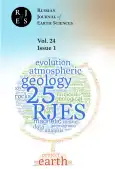Vol 24, No 1 (2024)
Articles
SEICHE DYNAMICS IN THE AZOV SEA CURRENT SYSTEM
Russian Journal of Earth Sciences. 2024;24(1):ES1001
 ES1001
ES1001


ACCUMULATION OF TECHNOGENIC AND NATURAL RADIONUCLIDES IN THE DON DELTA SEDIMENTS
Russian Journal of Earth Sciences. 2024;24(1):ES1002
 ES1002
ES1002


HIGH RESOLUTION SEISMICITY SMOOTHING METHOD FOR SEISMIC HAZARD ASSESSMENT
Russian Journal of Earth Sciences. 2024;24(1):ES1003
 ES1003
ES1003


CURRENT ISSUES PROBLEMS OF GEOINFORMATICS
Russian Journal of Earth Sciences. 2024;24(1):ES1004
 ES1004
ES1004


INFORMATION SUPPORT FOR GEOMECHANICAL CALCULATIONS OF STABILITY OF THE UNDERMINED ROCK MASS WITH A COMPLEX TECTONIC STRUCTURE
Abstract
Using the example of the Tyubegatan potash deposit (Uzbekistan), a complex of geophysical and geomechanical safety assurance for mining operations in conditions of the complex tectonic structure of the undermined rock mass is considered. Geophysical research included ground-based seismic surveys using a profile system in combination with «light» standard electro- and gravimetric techniques. Based on the results of these works, a physical and geological model of the deposit areas was built with the weakened zones and faults localization. As part of the meaningful interpretation, the physical and geological model was transformed into a geomechanical calculation scheme, which reflected the main mining-geological and mining-technical condition of development and was based on a model of elastoplastic deformation of salt rocks. The geomechanical model was calibrated from radar interferometric surveys. The time factor was taken into account in accordance with the developed modification of the well-known method of variable deformation modules. The formation of plasticity zones in physical terms was identified with the formation of fracturing areas in the water protection layer, which determine the danger of violating its continuity. Numerical implementation of the geomechanical model using the finite element method made it possible to substantiate the optimal parameters of the chamber development system, ensuring the safety of the water protection layer, including fault zones.
Russian Journal of Earth Sciences. 2024;24(1):ES1005
 ES1005
ES1005


THE POLYMETALLIC DEPOSITS OF THE WESTERN EUROPEAN PLATE AND STRUCTURE OF THE EARTH'S CRUST ACCORDING TO GOCE GRAVITY DATA
Russian Journal of Earth Sciences. 2024;24(1):ES1006
 ES1006
ES1006


STRUCTURAL TECTONIC SCHEME CREATION BASED ON SEISMIC-GRAVITY MODELS AND ISOSTASY USAGE: URAL CASE
Russian Journal of Earth Sciences. 2024;24(1):ES1007
 ES1007
ES1007


THE ROLE OF PLACER DEPOSITS IN ENSURING THE REPRODUCTION OF THE MINERAL RESOURCE BASE OF SCARCE TYPES OF STRATEGIC MINERAL RAW MATERIALS IN RUSSIA AT THE PRESENT STAGE
Abstract
Placer deposits had (and for a number of components still have) an important role in providing strategic types of mineral resource base for both Russia and the world as a whole. Placers have a number of advantages that make them in demand by the mining industry: relatively shallow (often accessible for open-pit mining) occurrence, disintegrated state of productive deposits, simplicity of enrichment processes (mainly gravitational systems), as well as the possibility of rapid involvement in exploitation, which significantly reduces payback period for investments. All this is even more relevant for modern Russia, when, in the shortest possible time, in conditions of a shortage of credit resources, it is necessary to implement a program of import substitution and provide the country with scarce types of strategic mineral raw materials, such as gold, platinum group metals, tin, rare metals, titanium, chromium, diamonds.
Russian Journal of Earth Sciences. 2024;24(1):ES1008
 ES1008
ES1008


A GLOBAL VIEW ON INTERNAL TIDES
Russian Journal of Earth Sciences. 2024;24(1):ES1009
 ES1009
ES1009


A CLOSER COOPERATION BETWEEN SPACE AND SEISMOLOGY COMMUNITIES – A WAY TO AVOID ERRORS IN HUNTING FOR EARTHQUAKE PRECURSORS
Russian Journal of Earth Sciences. 2024;24(1):ES1010
 ES1010
ES1010


THE CYCLOSTRATIGRAPHY OF THE EASTERN PARATETHYS KONKIAN: ZELENSKY SECTION (TAMAN PENINSULA)
Russian Journal of Earth Sciences. 2024;24(1):ES1011
 ES1011
ES1011


WORLD SEISMIC NETWORKS AND EARTHQUAKE CATALOGS
Abstract
This paper is devoted to the review of currently functioning seismological agencies, seismic monitoring networks created, developed and supported by them, as well as earthquake catalogs produced. Particular attention is focused on international and national seismological centers and seismic networks. A historical insight about the first observations made by seismic networks completes the picture. The basic parameters of the main seismic networks and the principles of functioning for seismological centers are considered. The key characteristics of seismic catalogs that determine the criteria for their quality are discussed. The system-analytical approach to solving the urgent problem of creating the most complete and representative earthquake catalogs with a unified magnitude scale by integrating data from international, national and regional catalogs in the studied region is presented.
Russian Journal of Earth Sciences. 2024;24(1):ES1012
 ES1012
ES1012











